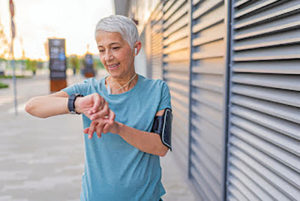 Rapid advances in healthcare technology allow many older adults to monitor their vital signs with a glance at their wrist. But is the wristband health technology accurate?
Rapid advances in healthcare technology allow many older adults to monitor their vital signs with a glance at their wrist. But is the wristband health technology accurate?
You’ve probably seen or heard of the multitude of health monitors you can strap on your wrist. And you might assume that they have passed testing to show that they are accurate and reliable. Well, think again.
Most wrist-worn health monitoring products that come on the market are not approved by the FDA. For example, Fitbit, Samsung and Apple devices all detect blood oxygen levels. However, none of them tie those readings to any medical conditions, so they did not need clearance from the agency before they were made available to consumers.
FDA Approved
There is one outlier. The Withings ScanWatch, which scans for abnormal heart rhythms via an EKG feature and also warns about breathing issues during sleep with a blood oxygen sensor, is the first unit to garner FDA approval on both features. The ScanWatch monitors blood oxygen levels, heart rate and movement to flag breathing problems that could indicate chronic obstructive pulmonary disease or sleep apnea, according to a company spokesman.
A study of the pulse oxygen feature was published in the Journal of Medical Internet Research and found that readings from the smartwatch and a standard pulse oximeter were virtually the same. An ongoing trial is evaluating whether or not the ScanWatch can accurately diagnose sleep apnea. Fitbit and Apple are working on similar products.
Sleep experts see the smartwatch as a potential means to diagnose sleep apnea at an early stage; the condition often goes undiagnosed. However, experts are cautious since doctors normally use other measurements in combination with those indicated by the watch to make a final diagnosis.
How Do Wearables Work?
Smartwatches shine a broad-spectrum LED onto the user’s skin and evaluate changes in the light that is reflected back. Some sensors in development use several discrete laser outputs from a single chip, enabling assessments of a variety of biometric markers including those in blood, interstitial fluids and different layers of skin.
As time goes on, you can expect wearables with a greater variety of health measurements and increased accuracy. But before you buy, make sure to do your homework and check how accurate the data is.
Hot Tip: Place your fitness tracker in a pocket near your hip for a more accurate step count. If you must wear it on an arm or hold it, use your non-dominant side.
SCSA (Society of Certified Senior Advisors)
The SCSA educates and supports specialists in aging dedicated to improving lives of older adults.
1-800-653-1875 | csa.us
Sources:
scmp.com/lifestyle/gadgets/article/3132243/apple-watch-monitor-blood-pressure-blood-sugar-and-alcohol-levels
modernhealthcare.com/technology/fda-approves-blood-oxygen-and-ecg-monitoring-smartwatch
ncbi.nlm.nih.gov/pmc/articles/PMC7055753/theverge.com/2021/10/12/22722333/withings-fda-clearance-blood-oxygen-heart-rhythm
techradar.com/news/no-the-next-apple-watch-wont-measure-blood-glucose-and-alcohol
health.harvard.edu/heart-health/how-accurate-are-wearable-heart-rate-monitors


Leave a Reply